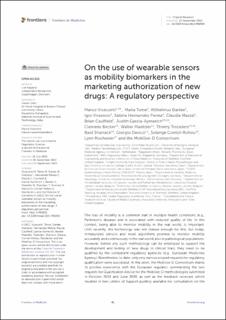On the use of wearable sensors as mobility biomarkers in the marketing authorization of new drugs: A regulatory perspective
| dc.contributor.author | Viceconti, Marco | |
| dc.contributor.author | Tome, M. | |
| dc.contributor.author | Dartee, Wim P | |
| dc.contributor.author | Knezevic, I. | |
| dc.contributor.author | Hernandez Penna, S. | |
| dc.contributor.author | Mazzà, Claudia | |
| dc.contributor.author | Caulfield, Brian | |
| dc.contributor.author | Garcia-Aymerich, Judith | |
| dc.contributor.author | Becker, Clemens | |
| dc.contributor.author | Maetzler, Walter | |
| dc.contributor.author | Troosters, Thierry | |
| dc.contributor.author | Sharrack, Basil | |
| dc.contributor.author | Davico, Giorgio | |
| dc.contributor.author | Corriol-Rohou, Solange | |
| dc.contributor.author | Rochester, Lynn | |
| dc.contributor.author | Mobilise-D, Consortium | |
| dc.contributor.author | Vereijken, Beatrix | |
| dc.date.accessioned | 2023-01-26T09:41:52Z | |
| dc.date.available | 2023-01-26T09:41:52Z | |
| dc.date.created | 2023-01-24T12:40:19Z | |
| dc.date.issued | 2022 | |
| dc.identifier.citation | Frontiers in medicine. 2022, 9 996903-?. | en_US |
| dc.identifier.issn | 2296-858X | |
| dc.identifier.uri | https://hdl.handle.net/11250/3046488 | |
| dc.description.abstract | The loss of mobility is a common trait in multiple health conditions (e.g., Parkinson's disease) and is associated with reduced quality of life. In this context, being able to monitor mobility in the real world, is important. Until recently, the technology was not mature enough for this; but today, miniaturized sensors and novel algorithms promise to monitor mobility accurately and continuously in the real world, also in pathological populations. However, before any such methodology can be employed to support the development and testing of new drugs in clinical trials, they need to be qualified by the competent regulatory agencies (e.g., European Medicines Agency). Nonetheless, to date, only very narrow scoped requests for regulatory qualification were successful. In this work, the Mobilise-D Consortium shares its positive experience with the European regulator, summarizing the two requests for Qualification Advice for the Mobilise-D methodologies submitted in October 2019 and June 2020, as well as the feedback received, which resulted in two Letters of Support publicly available for consultation on the website of the European Medicines Agency. Leveraging on this experience, we hereby propose a refined qualification strategy for the use of digital mobility outcome (DMO) measures as monitoring biomarkers for mobility in drug trials. | en_US |
| dc.language.iso | eng | en_US |
| dc.publisher | Frontiers Media | en_US |
| dc.rights | Navngivelse 4.0 Internasjonal | * |
| dc.rights.uri | http://creativecommons.org/licenses/by/4.0/deed.no | * |
| dc.title | On the use of wearable sensors as mobility biomarkers in the marketing authorization of new drugs: A regulatory perspective | en_US |
| dc.title.alternative | On the use of wearable sensors as mobility biomarkers in the marketing authorization of new drugs: A regulatory perspective | en_US |
| dc.type | Peer reviewed | en_US |
| dc.type | Journal article | en_US |
| dc.description.version | publishedVersion | en_US |
| dc.source.pagenumber | 996903-? | en_US |
| dc.source.volume | 9 | en_US |
| dc.source.journal | Frontiers in medicine | en_US |
| dc.identifier.doi | https://doi.org/10.3389/fmed.2022.996903 | |
| dc.identifier.cristin | 2113975 | |
| cristin.ispublished | true | |
| cristin.fulltext | original | |
| cristin.qualitycode | 1 |

